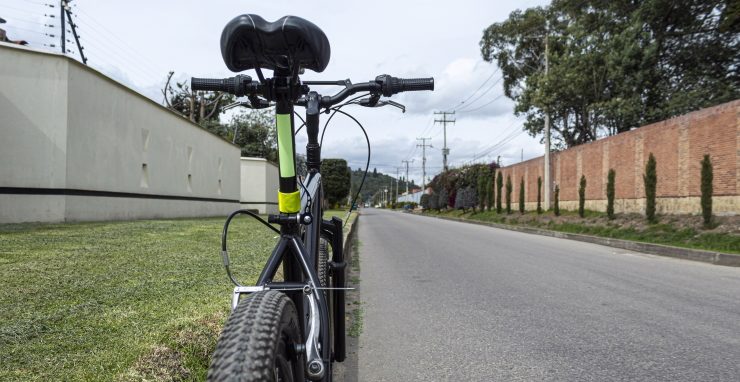The size of a mountain bike is as important as its features. Having the wrong size and fit reduces comfort, efficiency, and, most importantly, the amount of fun a bike can provide. Therefore, a mountain bike size chart is crucial when choosing your new mountain bike.
It might not always be easy to find the right size, especially because every person has a different body size. To make things worse, it does not end at big and small. People have varying body proportions; for example, two people of the same height may have different arm or leg lengths. Choosing the perfect bike involves selection based on frame size, geometry, and a couple of other factors – let’s check them all out here.
Page Contents
Frame Size
Frame size is the first thing to check when you want to find the right size of the bike. Most manufacturers offer a variety of frame sizes from extra-small up to extra-large. The selection of frame size can be done based on rider height and inseam length. Your inseam length is the distance from the ground to your crotch. Here’s a useful bike size calculator chart to help you determine the right size of frame based on these two factors:
| Your height | Your leg inseam | Suggested frame size | |||
| Feet/Inches | Centimeters | Inches | Centimeters | Inches | Size |
| 4`10”-5`1” | 148-158 cm | 24-29” | 61-73 cm | 14″ | XS |
| 5`1″-5`5″ | 158-168 cm | 25-30” | 63-76 cm | 15” / 16″ | S |
| 5`5″-5`9″ | 168-178 cm | 26-31” | 66-78 cm | 16” / 17″ | M |
| 5`9″-6`0″ | 178-185 cm | 27-32” | 68-81 cm | 17″ / 18″ | L |
| 6`0″-6`3″ | 185-193 cm | 28-33” | 71-83 cm | 18″ / 19″ | XL |
| 6`1″+ | 193 cm+ | 29”+ | 73 cm+ | 20”+ | XXL+ |
We also have a general bike size chart if you are looking to size a different type of bike. Don’t forget to check our page on sizing your child for a bike, if you are getting a new bike for your younger one.
The frame size letter will correspond to the size in inches as shown on the bike frame size chart in most cases. However, some manufacturers may have a different size range, meaning an L frame may be an M, or an S an M. It is good practice to always check the numbers instead of the letters. Some companies may even provide frame size in centimeters, like road bike frames. It is unlikely, however, that manufacturers will mention frame size in feet.
The mountain bike frame size chart given above is generic and can be considered unisex. However, some brands have different bike models for female riders, owing to different body proportions. The manufacturer will provide a men’s mountain bike size chart and a women’s mountain bike size chart separately in such a case.
If you find yourself between two frame sizes, choose the larger frame size if you have a longer torso or longer arms. A larger frame also provides an aggressive riding position. If you prefer a more upright position or have shorter arms, go for the shorter mountain bike frame size.
Wheel Size
Wheel size is another important factor to look for when figuring out the right bike size. Adults’ mountain bikes generally have wheel diameters ranging from 26” to 29”. Some manufacturers provide the same model in smaller sizes with 26” wheels and medium or larger sizes with 27.5” or 29” respectively. This is not exclusive to expensive bikes and even applies to mountain bikes under $1000.
Someone with a larger body might find larger wheels more comfortable. A larger tire size also helps roll over small obstacles relatively easily. The suggested frame height will always have a suitable wheel size for your height, which will often also be mentioned on the bike size calculator provided by the makers.
Frame Geometry
The mountain bike fit chart shown in the previous section is a great first step when you set out to find the right mountain bike frame size, but it might not be the last. Frame size is the length of the seat tube. Different manufacturers have different frame geometries, meaning the proportions between the seat tube and top tube or their angles may differ significantly.
You should also look at the bike’s geometry, even after ensuring you have the right frame based on the bike fit calculator.
Top Tube
Once you have selected the suggested frame size, the next important measurement to consider is the top tube height. The geometry charts might not be of much help here. You should be able to comfortably stand over without pressing against the top tube. You can try standing over the bike to make sure the top tube is not too high.
Once you are sure about the standover height, make sure the top tube length is correct. People with shorter arms may find it difficult to reach the handlebar from the seat comfortably. If the top tube on a certain bike is too long, try looking for another one that has a shorter reach. For minor adjustments, you can move the saddle forward or backward; however, moving it too much can make the ride less comfortable.
The reach may also be affected by the kind of bike you buy. For example, one with a longer suspension fork will have a different handlebar position.
Saddle height

Getting the right size and geometry in a bike frame wins you only half the battle. The next important part is adjusting the bike to your body. This can only be done once you have bought the bike, and mere size guides won’t help much. Even with the correct mountain bike frame size, you might need to make a few tweaks to maximize comfort and efficiency.
Saddle height is the most important among these adjustments. A saddle that is too high will cause difficulty in pedaling along with back pain issues, and a saddle that is too low will reduce comfort and your ability to push the pedal with enough power.
Adjust your saddle height to be high enough so that your leg is almost straight when the pedal is at the farthest position. The ideal way is to have a 15-20° bend in your knee.
Handlebar Position
Adjusting the handlebar position is something that may not occur to everyone, but even with the minor change of position it offers, you can experience a whole new level of comfort. Moving the spacers on the stem or inserting new ones to raise the handlebar can offer a more upright position. Some manufacturers even offer adjustable stems that can be moved up or down, changing the handlebar height.
The handlebar can even be moved horizontally by controlling the stem length. If you go for a shorter stem, you can move the handlebar closer, while a longer stem pushes it farther. This gives you the ability to adjust your reach without changing the saddle position too much.
Together, the saddle height and handlebar position can significantly impact how your bike feels and rides. If you plan on doing professional riding, you can even consider getting a professional bike fit done for a flawless, perfect fit. But for recreational riding, adjusting your bike settings on your own is sufficient and can even be fun in the sense that you get to learn something new.
For some, another criterion may be the weight. If you are between two sizes, you can check the difference in weight and go with a smaller frame for a lighter bike. Steel frames are heaviest, while aluminum frames are much lighter. Carbon-fiber frames are the lightest but are expensive. Anything available for under $2000 will be mostly aluminum or steel.
Having the correct bike size is crucial, as an incorrect size can affect everything from comfort to overall health in the long term. This comprehensive bike fit guide should help you make the right choice, whether you are looking among the top mountain bikes for less than $500 or willing to spend thousands.
